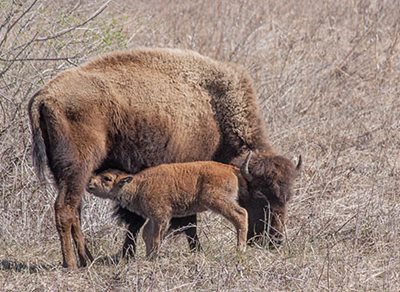Bison, new visitors, and skiers: investing in regional parks
June 2023
 This spring the prairies of the Spring Lake Park Reserve in Dakota County experienced something that’s been missing for generations — the birth of bison calves. The return of bison to Dakota County is a story about how partnerships can be formed around a common vision to create something extraordinary for future generations. It’s also one of many examples of how the Met Council, 10 regional park agencies, Governor Tim Walz, and Minnesota legislators came together this year to enhance regional parks.
This spring the prairies of the Spring Lake Park Reserve in Dakota County experienced something that’s been missing for generations — the birth of bison calves. The return of bison to Dakota County is a story about how partnerships can be formed around a common vision to create something extraordinary for future generations. It’s also one of many examples of how the Met Council, 10 regional park agencies, Governor Tim Walz, and Minnesota legislators came together this year to enhance regional parks.
Dakota County has been working to bring bison back to the prairie for some time, and last fall they finally got the first small herd through the Minnesota Bison Conservation Herd partnership. Getting ready for the bison required $1.5 million for fencing (bison need a substantial fence), gates, watering stations, and a paved trail and observation station. Funding came from Dakota County, a Minnesota Environment and Natural Resources Trust Fund grant, state Parks and Trails Legacy Funds, and state bond funds.
This year in Minnesota’s largest ever infrastructure bill Governor Walz and legislators approved more than $16 million for regional parks, and Dakota County’s share will help build a new cultural interpretative center at Spring Lake. Met Council will match these funds with more than $11 million in regional funds. The Prairie Island Indian Community and the Minnesota Zoo are also partners to explain the significance of bison in Minnesota, both past and present.
While the legislative work on taxes, budgets, and other policy issues garnered big headlines during the 2023 session, work on funding regional parks also progressed more quietly. Minnesotans share a common commitment to work together to preserve, protect and enjoy our natural spaces.
In addition to the state bonding appropriation, the state appropriated more $54 million in Parks and Trails Legacy funds, all of which are passed through directly by legislative formula to the 10 regional park implementing agencies.
Additionally, the state increased regional parks operations and maintenance funding by $1.5 million per year for the biennium with an ongoing annual increase. They also made a one-time $6 million general fund increase that will go to maintenance and upkeep of regional parks, ensuring our regional system is protecting past public investments.
 To top it off, the Governor and legislature funded an exciting new program to help modernize regional parks and trails to the tune of $9 million, which will be matched with $6 million in Met Council funds. Finally, there was a $1 million appropriation to help with the fight of the emerald ash borer and also with hazard tree removal.
To top it off, the Governor and legislature funded an exciting new program to help modernize regional parks and trails to the tune of $9 million, which will be matched with $6 million in Met Council funds. Finally, there was a $1 million appropriation to help with the fight of the emerald ash borer and also with hazard tree removal.
Here are just a few examples of the types of investments and programs this funding will support.
- The Minneapolis Parks and Recreation Board will acquire land to fill in the “missing link” of the Grand Rounds Scenic Byway, connecting the East River Parkway with Saint Anthony Parkway.
- The Three Rivers Park system will continue moving forward with its “Parks to People” program. This bridging effort seeks to connect new park visitors to parks activities and opportunities. These efforts to connect with new communities use innovative approaches such as joining community festivals to bring more visitors to parks, conducting group camping trainings, and operating a camping gear lending library.
- Ramsey County’s Battle Creek Winter Recreation Area brings snowmaking to the east metro. This makes it possible for high school sports programs to have access to reliable cross country skiing trails. As a result, Harding High School has been able to form its first Nordic ski team in decades.
Our regional parks and trails are incredibly popular, drawing more annual visits than Yellowstone, Yosemite, and the Grand Canyon combined. But they are also a place where we can all experience the state and region we love. Caring for them, and ensuring they continue to serve our region, is a labor of love that starts in the Governor’s office and touches counties, cities, neighborhoods, and residents. They are an example of how Minnesotans can dream and build good things together.
– Chair Charlie Zelle